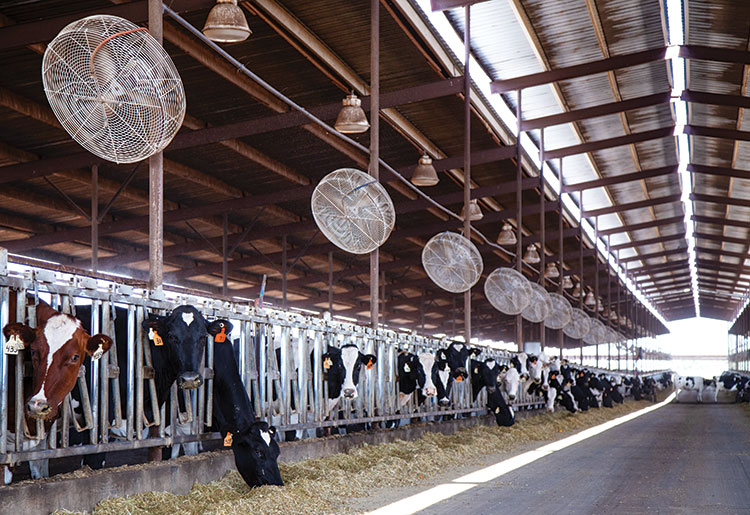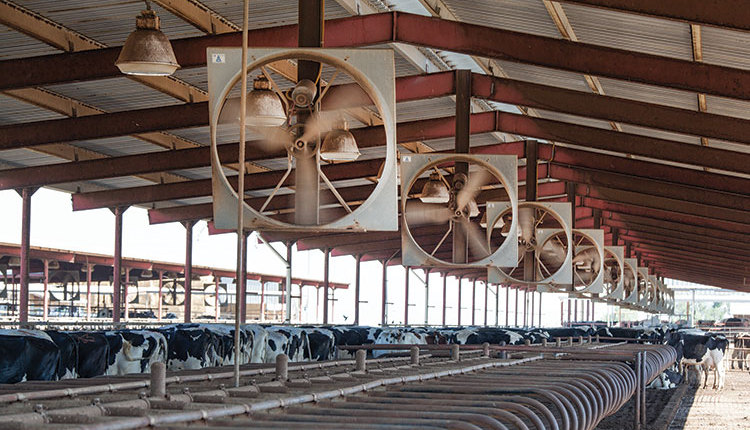
A ventilation system for adult dairy cows must provide fresh air year-round and fast-moving air in the resting space to aid summertime cooling. This is true for both naturally and mechanically ventilated barns.
While 85 percent of freestall facilities in Wisconsin are naturally ventilated, wind shadows (created by nearby buildings and seasonal cornfields), land availability, barn orientation, and other factors can limit the function of these systems. This has led to a growing interest in mechanical ventilation among dairy producers.
Mechanical ventilation relies completely on fans to provide an adequate ventilation rate and air speed in the cow’s resting area. Mechanical systems are generally defined as tunnel (airflow parallel to the feed lane) or cross (airflow perpendicular to the feed lane) ventilation. However, there is little information on the cost of installing and operating these systems.
Many producers have asked our team at The Dairyland Initiative for help deciding on a ventilation system for their facility. They often list cost (typically the initial investment) as one of their main concerns. We modeled the capital and operating costs of seven ventilation systems and found that while cost is important, it should not be the main focus of the design.
Each facility in our model was designed for 1,008 milking cows, and the systems were amortized over a 10-year period. The barns varied by ventilation system, fan or baffle placement, fan spacing over the stalls, and ventilation rate. The systems followed standard industry guidelines of summer ventilation rates (40 to 60 air changes per hour [ACH]), 4 ACH in the winter, and at around 500 feet per minute for the cross-sectional airspeed in the barn.
The study included:
Two naturally ventilated barns with fans installed on every support post (fans spaced 24 feet apart) or on every other support post (fans spaced — 48 feet apart).
Two mechanically tunnel-ventilated barns; one was designed for 60 ACH with no fans over the stalls and another was designed for 40 ACH with fans over the stalls spaced 5 diameter-widths apart.
A hybrid ventilation system combining mechanical and natural elements, designed at 40 ACH with fans over the stalls, spaced 60 feet apart, and ridge cupula fans to assist with winter ventilation.
Two cross-ventilated barns designed with airflow at 492 feet per minute under the baffle for an eight-row barn and a 16-row barn.
The analysis included the natural variability of the weather by modeling the cost of running the fans at various temperature set points, winter to summer transition methodologies, and temperature profiles (average versus minimum or maximum daily temperatures). Similarly, we included the variability of fan performance based on publicly available testing data for exhaust and circulation fans.
Crunching the numbers
The total building costs ranged from $2,460 to $3,180 per stall. Hybrid ventilation was the most expensive to build because it used mechanical ventilation and had full curtain sidewalls.
In facilities built for 1,008 milking cows, the cost of running ventilation for naturally ventilated barns was $29,584 per year in Wisconsin, about half that of mechanical ventilation systems. There was very little difference in total cost between tunnel ventilation ($58,554 per year) and cross ventilation ($55,802 per year) in Wisconsin at this facility size.
Similarly, ventilation systems in more temperate climates (Wisconsin, Washington, and Minnesota) cost about half as much to operate as those located in hotter climates (Arizona and Florida). This is mainly because the number of days the average daily temperature is above 68°F — at which the ventilation system operates at max capacity — is about double in hotter areas.
The right fan for the job
A natural ventilation system using poor-quality circulation fans can cost the same to operate as a mechanical ventilation system using high-efficiency fans. Fan selection had the highest impact on the operating costs for all ventilation systems.
We were surprised to see how much variance existed in fan performance and the relative importance of selecting an efficient fan. High-efficiency fans tend to be more expensive, but the investment is easily paid back by the lower operating costs over time.
Of the total cost of installing and operating a ventilation system for 10 years, on average, 24 percent of the total cost was the capital investment and the remainder was operating cost. Some high-efficiency fans also qualify for rebates from programs that were not part of the study and would further reduce the capital cost.
When selecting fans for ventilation systems, it is important to check the fan’s ventilation efficiency rating (VER), which is listed as CFM (cubic feet per minute) per watt. Untested fans can have ratings 50 percent less than what a manufacturer advertises, so it is important to find fans that have been independently tested.
The two most common testing facilities available in the U.S. are through the Air Movement and Control Association (AMCA) and the Bioenvironmental and Structural Systems (BESS) Laboratory at the University of Illinois. AMCA also has a certified product rating, and these products will bear an AMCA sticker stating what specific value was rated and certified.
Regardless of what fan is installed, agricultural fans are exposed to humid and dirty environments. Poorly maintained fans can lose 30 to 50 percent of their efficiency, and our experience suggests that fans are not well maintained on many farms.
One limitation of this analysis is that all fans were single-speed fans. Most ventilation companies now offer a variable speed drive (VFD) fan that is automatically controlled by temperature-sensing technologies.
In one of our previous studies for a cross-ventilated barn using VFD fans, fine-tuning the transition between summer and winter could, in theory, reduce operating costs by $6 per stall per year. This would be 10 to 25 percent of the ventilation operating costs.
If a ventilation and cooling system provides the recommended airspeed in the resting space occupied by the cow and fresh air throughout the year, it will always be a sound investment. When deciding between different types of ventilation systems for a new facility, other factors like day-to-day management, fan maintenance and number of fans, barn orientation, footprint per stall, cow flow, manure handling, or personal preference should outweigh the cost of the system, provided the right fan choice is made.
Based on our experience and results from these cost estimations, we believe that using the most efficient fan for each system, and following a proper maintenance protocol, surpass other energy-saving methodologies related to ventilation.







